Cove Boat was their first design. It basically consisted of two sheets of one eighth thick plywood with a simple frame to hold the plywood apart. The hull was a basic box shape eight by four feet by eight inches deep with a centre board, footwell, rudder and lateen rig to make life interesting. The hull being an enclosed box is unsinkable as we sometimes found in the swells in Moreton Bay near Coochymudlow Island and Wivenhoe Dam here in Australia. Sometimes the hull would be completely submerged if caught with a following swell. Freeboard when sailing two up was only a few inches. Wetwun tended to sail flat with a sail area of forty square feet. We did capsize her a few times when the gusts picked up.
|
Alternative rig. This one is a sprit sail using polytarp.Very easy to set up. |
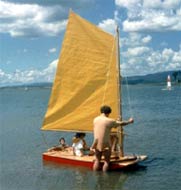 |
|
Building was completed using basic handtools with one or two powertools. A sail was sewed by one of my sisters and we started to sail Wetwun as she was named on our local sheltered waterways. After a time the sailing rig was changed to a sprit rig to make rigging easier. The new sail was sewed using good quality polytarp by my other sister. Wetwun was a fun little boat to sail and had a nice motion on the water. She was sold when interest in building ultralight aircraft took over.
|
My Tyro ultralight that I built and fly too. Cool and breezy from 3,000 feet. Great fun if you like flying and seeing the scenery from a different angle. One really learns the mystery of air movements and changes when flying very light aircraft like these. |
|
Two and a half aircraft later I was looking for a small boat to build to take on holidays and explore some of the lakes I flew over. Several criteria was required such as a hull one sat in with a back rest and if possible would use some of the offcuts and spare pieces I had collected.The new boat had to be light enough to carry on the car roof racks like Wetwun had been. Books by Dynamite Payson and John Welsford and others were consulted as well our local Australian Amateur Boatbuilder and Wooden Boat magazines. Information and plans were collected. Searches on the net were done which revealed the Summer Breeze design and others. Flat bottomed skiffs have their attraction in ease of building in plywood. Room to spread out whilst sailing was also an advantage if there was no centre board in the way. Being able to carry two folk with some gear would be useful for the tasks planned. For those who like to try angling SB is the perfect fishing accessory for sheltered waters.
Summer Breeze is very conventional in concept and won a design competion with Duckworks Magazine. David Beede deserves top marks for designing this very simple boat and presenting all the information on his very excellent web site. It’s called Simplicity Boats naturally and well worth a look.
Summer Breeze became the design to build as all I had to buy was some ply for the hull as well as epoxy glue, and cloth for the seams and bottom. The hull quickly became three dimensional as the pieces were joined. Inside chines were fitted and decks made for both ends as our version is for sail and oars only. Laminated gunwales completed the sides and all edges were rounded to make the hull more user friendly. Construction was easier as we now had a good collection of power tools to create sawdust. All the woodwork was epoxy sealed and varnished. Foam noodles were cut and glued under the decks for buoyancy.
Finished but still sanding before varnish. The bottom and all seams are covered with epoxy and cloth to add strength. The cross bracing is instead of a bulkhead as the area under the foredeck is planned for storage.
|
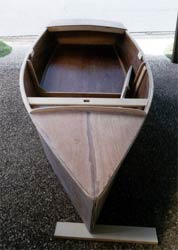 |
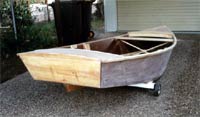 |
|
Oars were made and shaped as per the instructions found on the Bateau Boats site. It was a good job to do but in hindsight may have been a lot quicker and less dusty to purchase a pair from the chandlers. But then you do not learn as much. Finish was to be natural varnish to show the wood grain but after launching yellow enamel was applied to the hull after finding some shallow water with rocks present. We all took the little boat to Forest Lake for launching and a picnic. The local children at the lake enjoyed a ride too as they lined up to have a go.
|
SB is easily carried on the roof. A simple timber frame was made to fit over the roof bars to extend the width and hold the oars and rigging. |
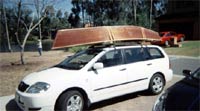 |
|
|
Launching. |
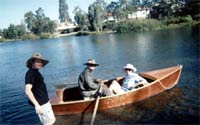 |
|
As a row boat SB has good speed when one up and is easy to row. My esky rowing seat feels too high.
|
Suz and Todd rowing at Forest Lake. |
|
At this stage the sailing rig still needed to be completed. The materials used included Bote Cote epoxy and cloth, polyurethane adhesive, luan/pacific maple ply, hoop pine, radiata pine, kauri pine, and local hardwood for the keel and skeg. The ply and glues coming from Boatcraft Pacific. Oars and a boom were shaped from radiata pine as per instructions found on the net. On the first outing a small esky ice box was used as a rowing seat but an alterative seat is planned to allow a lower position for better balance.
|
Marking out the tarp to look like a sail. Two of the original edges were used to save time. |
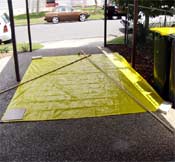 |
|
|
Completed sail. Our single garage in the background happens to be 34 feet long so what can I build next ? A long, long Long Micro perhaps or a Dolphin 19 would fit. |
|
Whilst buying materials for house renovations at Bunnings Hardware a yellow polytarp tarpaulin, double sided carpet tape and some eyelets were purchased to make the sail. Three hours later I was doing a trial fit of the rigging. The pieces were disassembled so the spars could be varnished. A few fittings from the chandler have been purchased to hold it all together. Having a rig that is easily adjusted and tweaked is a big advantage for these boats.
I like the homemade do it yourself approach. Having all the latest racing gear and design to pound around the buoys does not interest me so the old style traditional approach with modern techniques and materials suits me.
|
Trial Rig |
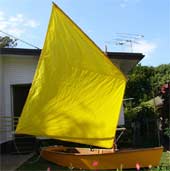 |
|
|
Rear view. |
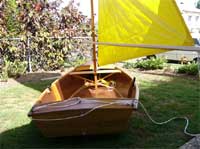 |
|
The moveable rowing seat has now been assembled from off cuts and will help lower the centre of gravity when rowing. It is designed to lock over the centre frame.
With everything ready my crew was organized for a trip to Runaway Bay on the Gold Coast for our sailing trials. Everything was loaded on the car. The weather on the day was almost perfect with a high pressure system over the area with light winds of five to ten knots.
|
Setting up |
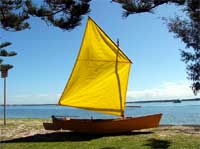 |
|
The sail needs further tweaking. Pulling the foot down reduced the wrinkles. The other water craft needed to be watched out for as they sped past sometimes too close for comfort.
|
Heading away |
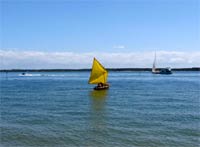 |
|
|
Perfect. Sailing is more relaxing compared to flying. In the right conditions both are enjoyable. |
|
A few tacks in different directions were tried with the wind from the south east. We found the lee board did not like to stay down at first. Tightening the bolt helped but some form of tie or bungee is needed. SB likes to sail heeled about five or ten degrees. Having some moveable ballast like Todd let us experiment. At times we sailed with the gunwale rail right on the water. We made good runs on a steady heading if the board was down or not when heeled. The hard chine helping in these situations. A run to South Stradbroke Island, a mile or so away, was made with a landing on the beach to tweak the rigging. In a few minutes a gentleman appeared asking questions like, what sort of boat is it , what sort of rig etc.
We were hit with wash from the power boats from all angles as they sped past. Side on or from the stern we bobbed around. From the bow we sliced through it when heeled or pounded when not. Stability of the design is good. With sixty square feet of sail area there is potential for lively sailing and speed when sailing single handed in a good breeze. SB is certainly faster than our first little boat. More comfortable for several hours sailing too and can carry a few goods like a tent or picnic gear safely. We found the moveable rowing seat was not needed as there was limited rowing to move away from the shore and the height was ok without it. A couple of cushions might help ones bottom for extended sailing.
Was Summer Breeze worth the effort to build? Certainly yes if she fits your needs like she did mine. I could have done it a little cheaper and faster without the glass sheathing on the bottom and transom or fittings from the chandler. My approach was to build SB with a view to using it a long time with minimum maintenance and provide a good finish to look at. Great little boat and worth a look.
Information I found useful:
www.simplicityboats.com David Beede’s site with lots of practical information and several designs.
www.bateau.com/free/simple_oars.html Easy to make oars. Everyone should do it once.
https://hometown.aol.com/polysail/HTML/lug.htm How to make easy sails using polytarp. They do work.
www.duckworksmagazine.com Good site for backyard boatbuilders with links to designers and ideas.
www.stevproj.com Has lots of good simple designs with low cost plans and ideas on building with links to builders.
www.microcruising.com Good site for micro cruisers including Matt Hayden’s Paradox cruiser.
www.svensons.com Lots of the olders plans shown from the old magazines when they were useful.
Wooden Boat Magazine needs no introduction.
Australian Amateur Boatbuilder magazine also needs no introduction for Aussies.
Instant Boats by Dynamite Payson and his other titles on Phil Bolger’s designs.
Build a Simple Dinghy by Nicolson and Reynolds for a British approach.
Backyard Boatbuilder by John Welsford is a great read.
The Duckflat Catalogue has lots of designs.
Boatcraft Pacific for materials and advice.

